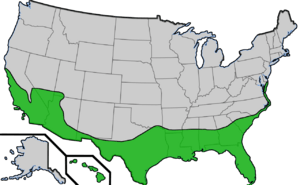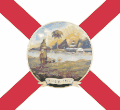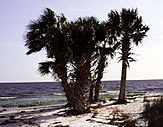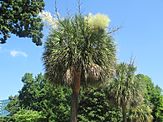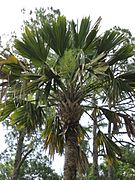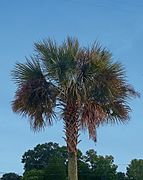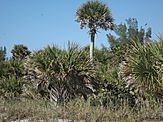Sabal palmetto facts for kids
Quick facts for kids Cabbage-palm |
|
|---|---|
 |
|
| Sabal palmetto in its natural home in Florida | |
| Conservation status | |
| Scientific classification | |
| Genus: |
Sabal
|
| Species: |
palmetto
|
| Synonyms | |
|
Synonymy
Corypha palmetto Walter
Inodes palmetto (Walter) O.F.Cook Inodes schwarzii O.F.Cook Chamaerops palmetto (Walter) Michx. Corypha umbraculifera Jacq. 1800, not L. 1753 Sabal blackburniana Schult. & Schult.f. Inodes blackburniana (Schult. & Schult.f.) O.F.Cook Inodes schwarzii O.F.Cook Sabal palmetto var. bahamensis Becc. Sabal parviflora Becc. Sabal schwarzii (O.F.Cook) Becc. Sabal jamesiana Small Sabal bahamensis (Becc.) L.H.Bailey Sabal viatoris L.H.Bailey |
|
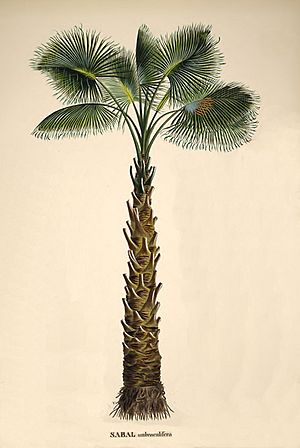
The Sabal palmetto (pronounced SAY-bəl), also known as the cabbage-palm or sabal palm, is a type of palm tree. It is one of 15 different kinds of palmetto palms.
You can find this tree growing naturally in the Southern United States, as well as in Cuba, the Turks and Caicos Islands, and the Bahamas. In the United States, it grows along the coast from southeast North Carolina down to Florida and west to Texas.
Contents
What Does the Cabbage Palm Look Like?
The Sabal palmetto can grow very tall, up to about 20 meters (65 feet). Its leaves are shaped like a fan, but they also have a strong middle rib, making them a bit different from a typical fan palm. Each leaf can be about 5 millimeters (0.20 inches) wide.
The tree also produces large groups of flowers, called panicles, which can be up to 2.5 meters (8.2 feet) long. After the flowers, small black fruits grow. These fruits are about 1.3 centimeters (0.5 inches) long and each holds one seed.
This palm is very good at handling salty conditions. You often see it growing close to the Atlantic Ocean and the Gulf of Mexico coasts.
Where Cabbage Palms Grow Best
The Sabal palmetto is a tough tree. It can handle cold temperatures down to about -13 degrees Celsius (8.6 degrees Fahrenheit). However, it needs warm and humid summers to grow well.
This palm is easy to care for and can adapt to many different places. It can survive in dry conditions, in standing water, and even in slightly salty water. While it can handle dry spells, it grows best with regular watering and feeding. It's also very good at resisting salty winds, but it doesn't like being flooded by saltwater.
History and Uses of the Cabbage Palm
People have used the cabbage palm for many things throughout history.
- Food: The soft, inner part of the new leaves, called the "heart of palm," can be eaten. It tastes a bit like cabbage or artichoke. Native Americans often ate it. However, taking this part kills the palm tree because it's the only place the tree can grow new leaves.
- Tools: The rough fibers from young leaves were used to make scrubbing brushes.
- Building: The strong trunks of the trees were used as sturdy posts for docks and piers.
- Defense: During the American Revolutionary War, on June 28, 1776, patriots in Charleston, South Carolina, built a fort using palmetto trunks. This fort helped them successfully defend against the British army.
Cabbage Palm in Gardens and Landscapes
The Sabal palmetto is a popular tree for planting in warm areas. People like it because it can handle salt spray and dry weather. It can also survive moderate cold.
Most of these palms are not grown from seeds in nurseries. Instead, they are often dug up from the wild. When moved, most of their old roots die, and new ones grow in the new spot. Many leaves are removed before moving to help the tree survive.
The cabbage palm is the official state tree of both South Carolina and Florida. It is known for being very strong against hurricanes. However, sometimes people cut off too many of its leaves, which can harm the tree.
Special Features of the Cabbage Palm
The trunks of Sabal palmetto trees can look different. When old leaves die, their bases often stay on the trunk for a while. These leftover leaf bases are called "bootjacks" or "boots" because they look like the "Y" shaped tools used to take off boots.
When palms are moved, these bootjacks are sometimes removed on purpose. Taller, older trees are more likely to have lost their bootjacks naturally, making their trunks look smooth and straight.
The "Lisa" Cabbage Palm
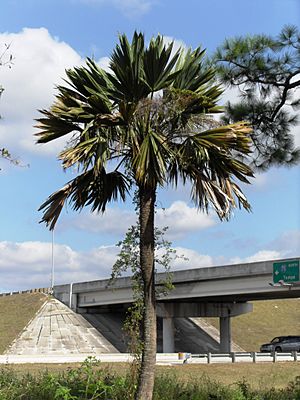
In 1998, a new and special type of Sabal palmetto was found in Florida. It was named Sabal palmetto "Lisa." This type has unusually thick, strong leaves that are mostly joined together, giving it a unique and pretty look.
More than 60% of the baby plants from a "Lisa" palm will have the same special leaves as the parent. Over the last 20 years, the "Lisa" palm has become popular in nurseries in Florida. It is just as strong against heat, wind, cold, dry weather, and neglect as the regular cabbage palm, but it keeps its special shape.
Cabbage Palm as a Symbol
The sabal palmetto is a very important symbol. It is the official state tree for both Florida and South Carolina. South Carolina is even called "The Palmetto State."
- Flags and Seals: A picture of a palmetto tree appears on the official flag of South Carolina. It also appears on the back of South Carolina's State quarter, which came out in 2000. Two images of the Sabal palmetto are on the official great seal of the State of Florida and the Flag of Florida.
- Sports: The yearly football game between Clemson and the University of South Carolina is even called the "Palmetto Bowl."
Gallery
-
S. palmetto can grow where it's washed by sea water at high tide. The young palm in front still has its "bootjacks," while the palm on the far right has lost them. Virginia Beach, Virginia
-
S. palmetto growing near the South Carolina state capitol in Columbia -
A Sabal palmetto in the Canaveral National Seashore, Florida
-
A Sabal Palmetto in Enterprise, Alabama.
Images for kids
See also
 In Spanish: Palma de abanico para niños
In Spanish: Palma de abanico para niños



